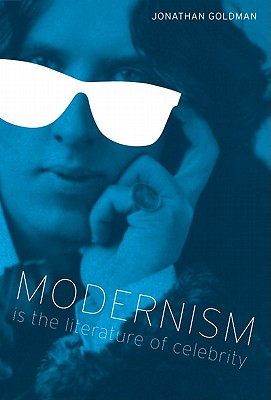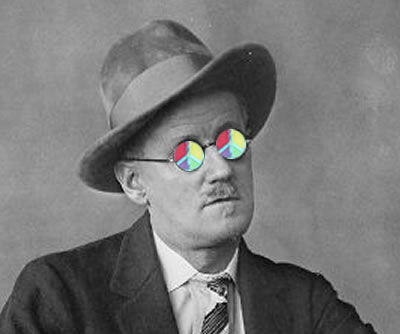Book Review: Matinee Modernism — Celebrity and Academia Converge and It Isn’t Pretty
What could have been a readable, informative, pleasurable book that would, much like Woody Allen’s recent film MIDNIGHT IN PARIS, enhance our experience of some of the modernist figures we adore wallows too often in brain-dead literary theory.
Modernism is the Literature of Celebrity by Jonathan Goldman. University of Texas Press, 216 pages, $55.
By Christopher M. Ohge
I write for myself and strangers — Gertrude Stein
At a recent orientation for a group of incoming Fulbright students, I assisted a mini-seminar in which they responded to Robert Scholes’s 2004 Modern Language Association Presidential Address, “The Humanities in a Posthumanist World,” which speaks to the current “crisis” in humanities and suggests the humanities are not taken seriously because many professionals in the humanities became too self-absorbed in theory, among other things, and that they no longer do work that is meaningful to, well, most posthumanist humans. What a conundrum.
Jonathan Goldman’s book, Modernism is the Literature of Celebrity, is symptomatic of the crisis. (And guess who blurbs the book? Scholes, of course—“clearly written, and very persuasive.”) The volume’s cover is quite welcoming: an azure-tinted portrait of Oscar Wilde, who is deftly adorned with hipster-conscious, white, wayfarer sunglasses. The image suggests a readable, informative, pleasurable book that would, much like Woody Allen’s recent film Midnight in Paris, enhance our experience of some modernist figures we adore. Then the first page of the introduction has a quote from The Simpsons.
Yet merely a dozen or so pages into Goldman’s book, this appreciator of modernism felt hoodwinked. While undoubtedly well-researched and interesting, this study falls short of appreciating the figures in question (Oscar Wilde, James Joyce, Gertrude Stein, Charlie Chaplin, Jean Rhys, and, sort of, John Dos Passos). Instead, Goldman tries to situate these authors within their “historical moments” and see how their work “reconfigures cultural issues.” Thus the impenetrable center of this book draws on the professional English Department orgy [Marx-Lukács-Barthes-Derrida-Foucault] to theorize about why we currently celebrate—or is it cerebrate?—these authors. Goldman is at his best when he drops the heavy thinking and lucidly contextualizes about the authors’ relationship to their culture—the masses, the media, and their peers.
The chapter on Wilde’s turn to fame, and infamy, revolves around Wilde’s tour of America in 1881, noting frequently the witty remark the writer made when he walked into U.S. Customs: “I have nothing to declare except my genius.” This “reading” of Wilde clarifies that his trademark look, amplified during his tour, was in fact a copy of a character from Gilbert and Sullivan’s operetta Patience, which Wilde was paid to promote on tour. In fact, he was derided by some contemporary critics as a sham, or an “$-sthete.” Wilde eventually embraced this stereotype and then worked at stereotyping himself, a melding that was arranged via public caricatures as well as in his novel The Picture of Dorian Gray.
Goldman also notes that Wilde’s image was then regarded as effeminate but not necessarily homosexual (effeminacy was actually viewed by some then as a means to unfairly attract women). It is curious, however, that Goldman does not address Wilde’s tragic mistake following the success of The Importance of Being Earnest in 1895. During opening night of Importance, his lover’s father, the Marquess of Queensbury, began a smear campaign about Wilde’s homosexuality (being too earnest, they would say); this led Wilde to sue Queensbury for libel to clear his name, the action of which set in motion his conviction for “gross indecency” about a year afterward. Instead, Goldman focuses instead on Wilde’s being a “tragic commodity.”
Wilde’s celebrity changed after his conviction. Written in jail in 1897, De Profundis “ultimately implies a retreat into the aesthetic realm,” Goldman writes. Wilde’s celebrity, though unending to us now, upended him because he lost control of it.
Alongside “commodities” and “modes of author-production,” and other Marxist-tinged terminology, Goldman speculates about how Wilde, a “disembodied subject,” becomes a “complete subject” in his De Profundis and how he no longer relied on the “social body” and rejected his “to-be-looked-at-ness” in order to be like Christ: a representation of a “stable essence.” Simple enough.
Joyce is an interesting case because he was not really much of a celebrity. Goldman admits this, yet forges ahead, arguing that Joyce exemplifies the “modernist exception.” Here celebrity results from style and intellectual elitism. That Ulysses was used by editors of The Dial in 1922 to promote the publication of T. S. Eliot’s The Waste Land signaled the force of Joyce’s value among the literati — “the brand name Joyce would conjure up a mixture of modernist difficulty, virtuosity, and elusiveness.” Eventually, Joyce created the novel Ulysses, which, in turn, created him as celebrity.

Gertrude Stein — She initiated a type of memoir-writing that valued name-dropping more than personal details.
The chapter on Stein turns out to be the most rewarding in the study because Goldman successfully guides us through a most difficult topic: Stein’s experimental language. Arguing that Stein, like Joyce, exemplifies the modernist exception, Goldman points out that Stein’s particular celebrity came from knowing a lot of famous people. As evident by her Autobiography of Alice B. Toklas and Everybody’s Autobiography, she initiated a type of memoir-writing that valued name-dropping more than personal details.
Stein’s “flattening of celebrity” and “ethos of instability” distinguishes her work, which is notoriously repetitious and devoid of references. Yet the examination of Stein, a fascinating and still misunderstood subject, is peppered with forays into the “space” infested by lit-critters, or literary critics who leave me scratching. (“To pirate Jacques Lacan’s terminology, itself taken from Ferdinand de Saussure, the names produce value not only ‘vertically’ . . . but also ‘horizontally’,” thus “destabilizing” the meaning of names.”)
Strangely, Goldman treats Charlie Chaplin as a bona fide modernist author, even though he did not write any poems or novels. “Chaplin uses the logic of celebrity to create the author, enlisting the familiarity of his tramp image to produce himself as the creator of the film, an idealized subject who authors textual signification,” Goldman writes in characteristic fashion. Chaplin’s celebrity comes from a pervasive image-recognition that transcends his role in a given film (what does this say about his acting ability?). Nevertheless, the academic’s analysis of Modern Times and The Great Dictator provide a nice break from the arcane literary chatter, and his investigation of the evolution of Chaplin’s Tramp provides a good example, apropos Wilde, of the celebrity being destroyed by his own celebrity.
Rhys, not unlike Joyce, is a strange case because she functions as a “celebrity on the margins” whose “history suggests a chronicle more of obscurity than of fame.” Is this just a fancy way of saying she is a cult figure? Why include her? His treatment of Rhys is clearly a bit cagey, as she merely “conforms to the modernist gestures that I have shown to correspond with the creation of the celebrity.” Still, Goldman’s offbeat approach to Wide Sargasso Sea, exploring how Rhys’s novel examines the outcast’s relationship to the masses, made me want to revisit her work.
Ultimately this book is a testament to historicizing literature (i.e. historical moments, reconfiguring cultural issues). To be fair, this is precisely what Goldman wants to do, and I’ll admit that my disagreement as a practical critic is largely ideological.
Yet throughout this book, straightforward ideas are too often muddied by vague jargon. He employs the words “subject” (usually juxtaposed with “body” or “object”) and “celebrity logic” often, as if we all agree on what he means by these elusive terms. Some grounding of those references could have helped the book and given it more cross-disciplinary appeal. More than once Goldman audaciously concludes a paragraph with “Once one recognizes x‘s formula . . . then one does not need to read the text.” Sometimes his formulas (my ideas on Joyce are a lot like Barthes, who says in The Death of the Author . . .) are coupled with cheekily daft writing (see the sub-heading: “E.T.: The Extra-Textual”) that presumably functions as a foil to the clotted academic writing. Most of the time, however, his execution of literary theory is as docile as it is humdrum.
Which writer is famous to whom, and why? At the end, I am still puzzled. Modernism Is the Literature of Celebrity recalls Gertrude Stein’s joke about two predictably difficult artists: “Braque and James Joyce, they are the incomprehensibles whom anybody can understand.” Goldman includes the quotation, but I doubt he got the joke.




Reading any contemporary criticism just leaves me longing for Randall Jarrell….
Oh please. To complain about academic “jargon” is tired and clichéd itself, a contribution to the great dumbing-down of American culture. Cultural theory is a complex field; complex ideas require specialized terminology. Would you read an academic book containing economic theory and resent the specialized language? No. You admit yourself that Scholes calls this book clear. Maybe reviewers should attempt to understand the terms in a work before they engage in facile critiques?
I just finished reading this excellent book, went searching for reviews, and found this page. Modernism Is the Literary Celebrity is primarily a strong and convincing argument that modernist styles and personas developed in a manner similar to celebrity. It is quite enjoyable to read, balancing its nods to previous theory and criticism with impressive textual analysis and witty factoids. (Indeed, there is a lot of research here.)
It seems this reviewer decided to not engage with Goldman’s book, preferring, to vent his own attitudes toward academic writing (attitudes which, as the previous response says, are out of date and clichéd). This volume’s writing is clear (as Scholes himself says), and the terminology that the reviewer cites is explained, defined, and contextualized at length in the book. When the reviewer asks “Which writer is famous to whom, and why?” he makes it obvious he hasn’t tried to understand the argument.
Count me among those who have read the book, found its terminology purposeful and transparent, and think that Christopher M. Ohge seems not to have read it. I expect more from ArtsFuse reviewers.
Sounds like a good book. Thanks for the write-up.